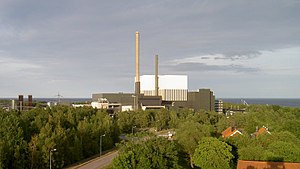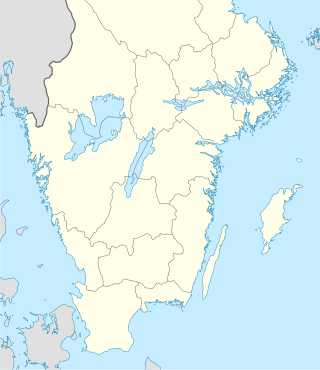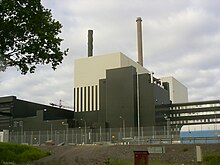Oskarshamn nuclear power plant
| Oskarshamn nuclear power plant | ||
|---|---|---|
| The Oskarshamn nuclear power plant | ||
| location | ||
|
|
||
| Coordinates | 57 ° 24 ′ 56 " N , 16 ° 40 ′ 16" E | |
| Country: | Sweden | |
| Data | ||
| Owner: | OKG Aktiebolag | |
| Operator: | OKG Aktiebolag | |
| Project start: | 1965 | |
| Commercial operation: | Feb 6, 1972 | |
|
Active reactors (gross): |
1 (1450 MW) | |
|
Decommissioned reactors (gross): |
2 (1153 MW) | |
| Energy fed in in 2006: | 15,736 GWh | |
| Energy fed in since commissioning: | 540,340 GWh | |
| Website: | Operator's homepage | |
| Was standing: | 18th December 2019 | |
| The data source of the respective entries can be found in the documentation . | ||
The Oskarshamn nuclear power plant is one of five (including three active) nuclear power plants in Sweden .
The plant is located about 30 kilometers north of Oskarshamn directly on Kalmarsund on the Baltic Sea coast and produces electricity with the Oskarshamn 3 reactor. All three blocks are boiling water reactors .
Unit 1 had an installed capacity of 492 MW , Unit 2 had 661 MW. The newest reactor block 3 had an installed capacity of 1,194 MW and was expanded to 1,450 MW in 2008.
Clab, the central interim storage facility for spent fuel elements from all Swedish reactors, is also located on the site of the plant .
operator
The operator is Oskarshamnsverkets Kraftgrupp AB , OKG for short , which has belonged to Sydkraft (now a subsidiary of Uniper ) since 1993 . Sydkraft owns 54.5 percent and the other partner Fortum 45.5 percent in OKG.
history
The Oskarshamn power plant is located on the Simpevarp peninsula at a location that was used as a burial ground in early human history. This burial ground, consisting of several rows of stones and at least one pile of stones with no significant finds, was completely removed in the course of the construction work. In addition, a collection of stones, which had probably served as a sea mark, was removed.
At the beginning of the suitability test for the construction of the power station in the 1950s, the Simpevarp peninsula was still characterized by agriculture and fishing. In 1955, a nuclear power consortium was founded with Krångede and Sydkraft as the largest shareholders, and four years later, in 1959, an application was submitted to build a nuclear power plant at this location. In 1962 the land in question was bought from the residents, who subsequently left the peninsula.
On July 14, 1965, the Oskarshamns Kraftgrupp (OKG) was founded and the construction of a reactor with 400 MW was commissioned from ASEA-Atom (a subsidiary of ASEA ). The following year the government approved the site and construction began. Five years later, in 1971, the Oskarshamn 1 reactor went online. In the following year, the Oskarshamn nuclear power plant was built by the then King Gustav VI. Adolf inaugurated.
In 1974 the Oskarshamn 2 reactor, which was applied for in 1967 and approved in 1969, was connected to the grid with an output of 600 MW.
After the partial meltdown in the American nuclear power plant Three Mile Island 2 in 1979, a referendum on the future of nuclear energy followed in Sweden in March 1980, in which the electorate voted for a gradual phase-out of nuclear energy. As a result, the Swedish Parliament decided in 1980 that no more nuclear power plants should be built. The Oskarshamn 3 project with 1,000 MW, which was already under construction or planned, as well as the CLAB central interim storage facility for spent fuel elements from all Swedish reactors were still completed and both were inaugurated in 1985.
In the following years, all three reactors were modernized as part of various projects and their output increased.
After a serious incident occurred at the Forsmark nuclear power plant on July 25, 2006, two similarly constructed units ( Unit 1 and Unit 2 ) in Oskarshamn were temporarily shut down. On December 21, 2006, the AREVA NP, Siemens and Heitkamp consortium was commissioned to modernize and expand the capacity of the 2nd reactor block to 845 MW. The planned completion was in 2013. At the end of March 2014, the expansion of services was postponed.
On May 21, 2008, during a check for explosives-related chemicals, the presence of triacetone tetraperoxide (TATP) was reported by two craftsmen. But it could also be traces of smoke from a rifle. The power plant site was then cordoned off. The two craftsmen were busy with service work on the disconnected block 2 for insulation work. These are not employees of the power plant, but of a craftsman's company. The men were then provisionally arrested on suspicion of sabotage. From evening until the next day, the police searched the entire facility of Reactor 2 with detection dogs without any further traces of explosives being found. During their time in the nuclear power plant, the men moved freely across the site and also stayed in safety-relevant rooms and near the reactor.
On October 23, 2011, a fire broke out in the turbine hall of reactor 2 due to an oil leak, which, however, could be extinguished quickly with hand-held fire extinguishers.
On December 6, 2012, the nuclear supervisory authority Strålsäkerhetsmyndigheten (SSM) announced that reactor 2 had to be shut down immediately because the operator had not complied with safety requirements: the installed diesel generators should not have worked reliably. A maintenance due in 2011 on one of the four generators had not been carried out until the decommissioning notice, the SSM announced.
On December 20, 2012, the nuclear power plant was placed under “special supervision” by the Swedish Nuclear Regulatory Authority, the last stage before the operating license was withdrawn. The reason given for this was that the operator could not get several security problems under control. Accordingly, u. a. The emergency power generators, which were installed after a conversion of reactor 1 in 2002 and serve to ensure the safe cooling of the reactor even in the event of a power failure, were not operational until December 2012. According to its own statements, the nuclear supervisory authority had not noticed this so far, since the reactor operators are responsible for safety and they only exercise supervision. Since she does not have the resources to control everything herself, she has to rely on reports from the operators.
On the night of September 29th to 30th, 2013, the Oskarshamn nuclear power plant had to be shut down unscheduled due to jellyfish blocking the cooling sea water pipes . After repairing the damage, the nuclear power plant went back online on October 2nd.
In June 2015 E.Ons announced plans to immediately initiate the execution phase in Block 2. On October 14, 2015, the operating company OKG, consisting of E.On and the Finnish electricity company Fortum , announced that the second block of the NPP should no longer be started up again. The final shutdown did not take place until December 22, 2016.
For block 1, the plans provided for an early end in 2017, at the latest in 2019. The date for this was finally June 29, 2017, but on June 17, a malfunction led to the automatic shutdown and at a meeting held on June 19 for this purpose it was decided not to drive to the block again for the remaining 10 days .
Data of the reactor blocks
The Oskarshamn nuclear power plant has a total of three blocks , all with boiling water reactors :
| Reactor block | Net power | Gross output | feed | start of building | Network synchronization | Commercial operation | Shutdown |
|---|---|---|---|---|---|---|---|
| Oskarshamn - 1 | 473 MW | 492 MW | 110 TWh | 08/01/1966 | August 19, 1971 | 02/06/1972 | 06/19/2017 |
| Oskarshamn - 2nd | 638 MW | 661 MW | 154 TWh | 09/01/1969 | 10/02/1974 | 01/01/1975 | 12/22/2016 |
| Oskarshamn - 3rd | 1400 MW | 1450 MW | 276 TWh | 05/01/1980 | 03.03.1985 | 08/15/1985 | in operation |
See also
Web links
Individual evidence
- ↑ a b Power Reactor Information System (PRIS): Nuclear power plants in Sweden, summary . In: International Atomic Energy Agency (IAEA )
- ^ History of OKG ( English ) Oskarhamns Kraftgrupp (OKG). Retrieved December 18, 2019.
- ↑ Making the upgrade ( English ) Nuclear Engineering International. June 3, 2002. Retrieved May 18, 2019.
- ^ The Oskarshamn extra ( English ) Nuclear Engineering International. April 15, 2009. Retrieved May 18, 2019.
- ↑ Four nuclear power plants shut down after a serious incident . In: Der Spiegel from August 3, 2006. Retrieved May 18, 2019.
- ^ Oskarshamn-2: Increase in performance postponed . In: Nuclear Forum Switzerland of March 25, 2014. Accessed on May 18, 2019.
- ↑ Further confusion about the nuclear power plant incident in Sweden . In: Handelsblatt of May 21, 2019. Retrieved May 18, 2019.
- ^ Fire in the Swedish Oskarshamn nuclear reactor . In: Berliner Morgenpost of October 23, 2011. Accessed on May 18, 2019.
- ^ Authority orders immediate shutdown of the reactor at the Oskarshamn nuclear power plant . In: Radio Sweden, December 6, 2012. Retrieved May 18, 2019.
- ↑ E.ON nuclear power plant to be shut down . In: International Economic Forum for Renewable Energies (IWR) of December 7, 2012. Accessed on May 18, 2019.
- ^ Eon nuclear power plant in Sweden. Nuclear power plant without emergency power for ten years . In: taz , December 20, 2012. Retrieved December 21, 2012.
- ↑ Jellyfish paralyze the nuclear reactor . In: Süddeutsche Zeitung of October 2, 2013. Accessed on May 18, 2019.
- ↑ Eon's escape from nuclear power . In: klimaretter.info of June 26, 2015. Accessed on May 18, 2019.
- ↑ Early Retirement for Pioneer Plant after 45 Years of Service - June 19, 2017 ( Memento of July 6, 2017 in the Internet Archive )
- ↑ Sweden: Oskarshamn-1 finally ceases operations . In: Nuclear Forum. Media release from June 19, 2017. Retrieved May 18, 2019.
- ↑ Closure of Oskarshamn 1 on June 19, 2017 . In: Power Reactor Information System (PRIS) of the International Atomic Energy Agency.
- ^ Oskarshamn 2 closed on December 22, 2016 . In: Power Reactor Information System (PRIS) of the International Atomic Energy Agency.


